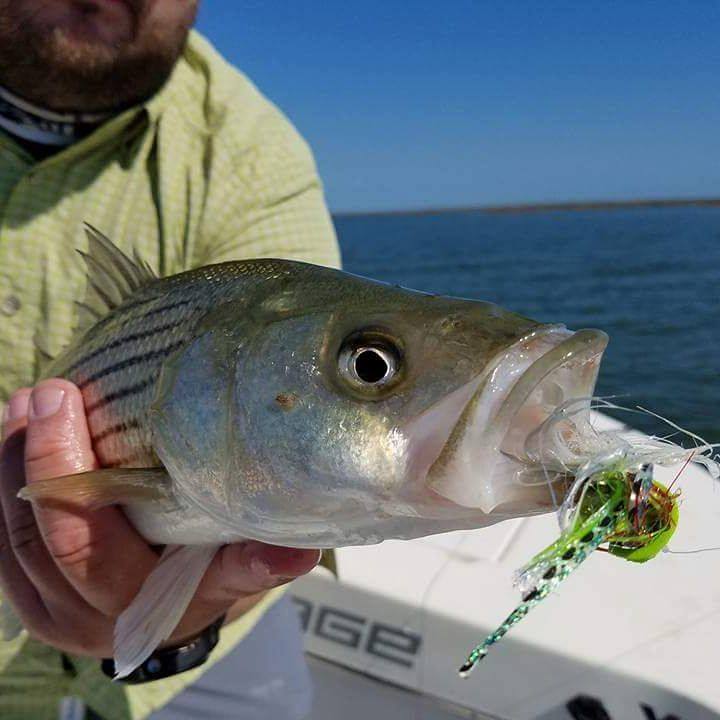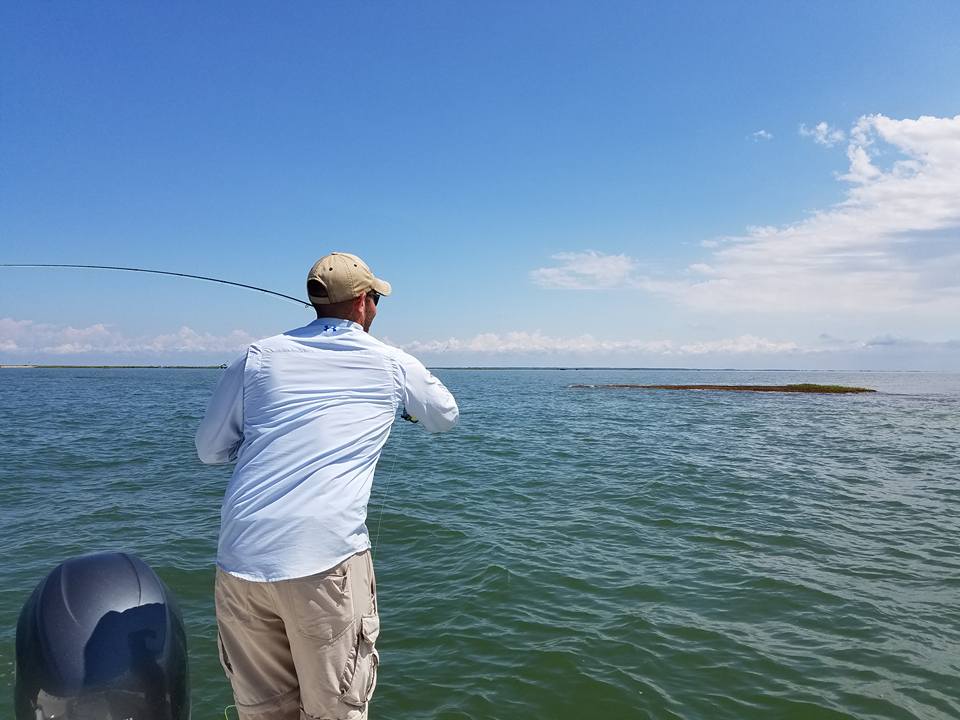You can get lucky when fishing with bait or dragging lures through open water—even a blind squirrel finds a nut now and again—but when it comes to fly fishing in saltwater, experience and know-how become imperative for success. And we know there are a lot of you out there who want to find success in the brine while fishing on the fly. So we went to a local expert, guide Chris Karwacki from Chesapeake on the Fly charters, to learn some tips, hear about some of the mistakes we should look out for, and get some expert advice.

Saltwater Fly Fishing Tips
FishTalk: What is the one thing you have to say over and over again to help your clients catch fish?
Karwacki: Relax your casting stroke and let the rod do the work for you. Trying to overpower the casting stroke usually results in a horrible cast. Rod designers spend lots of time and money creating the perfect rod actions—swinging the rod like caveman invalidates all that work.
What's the most important thing the average angler can do to improve their casting?
The double haul is an effective technique that will allow you to increase your line speed and make for a longer cast. This is when you use the hand opposite of the one holding the rod to pull the line on the casting stroke. Doing this allows the rod to be loaded more deeply, and that transfers greater energy into your line. Line management is also very important. Be aware of all that line laying on the deck. Is it knotting up? Are you standing on it? This will quickly ruin your cast. Perhaps a free-standing stripping basket will help keep your line organized, especially on a windy day. And to improve accuracy, one tip is too point the thumb of the hand gripping the rod in the direction of your target. Most important, however, is practice and time on the water.
What's the most important single piece of advice you'd give to people as they're choosing a fly/streamer/lure for striped bass in the shallows?
I think it’s important in both open and shallow water situations to choose a fly that has a profile similar to that of the predominate species of forage fish. For example, when stripers are feeding on herring on the Susquehanna Flats, it can be important to use a large profile fly. If speckled trout are feeding on silver-sides in the shallows over a submerged stump field, a small Clouser-style minnow weighted so the hook point rides up will help match the hatch—as well as help prevent any snags on the stumps.

Fly Fishing Mistakes
Do some fishermen have preconceived notions that make it harder for them to catch fish?
Sometimes they do. While I do get a lot of excellent fly casters with experience under their belts, I also get a lot of first timers. They envision the perfect day on the water: light winds, making beautiful casts to willing fish, getting that hero shot of them with a trophy fish cradled above the fly rod. While these days do happen, they are far and few between. Many days on the Chesapeake are not conducive to fly fishing, mainly due to wind. Showing up without any casting practice under your belt can make for a very difficult and frustrating day.
What mistakes do you commonly see regarding casting techniques? Retrieve techniques?
Quite a few. Many anglers new to the salt false-cast too much. For those not in the know, false-casting is the classic forward and backwards fly casting stroke that is often seen on a trout stream. This cast is what is commonly taught to new fly anglers. Many of my clients have never cast, let alone heard of, a sinking line. These lines are weighted with metal dust and require a very different cast, oftentimes requiring just one slow, open-wrist back cast, and then one progressively faster forward cast. Too often, anglers will try to do multiple false-casts with these lines. The line will simply collapse, thus resulting in only a 10 to 20 foot cast. In many instances, I’ve seen an angler’s cast get shorter and shorter with each false cast. Add wind to the equation, and it becomes even more of a challenge. It takes some getting used to. I can’t overemphasize the importance of practicing before your trip, even if it’s in your back yard.
As far as retrieving goes, you must strip the line quickly to move the fly through the water. You are trying to mimic a swimming/fleeing bait fish. A lot of new anglers don’t realize how fast you have to strip the line to mimic that motion.
What mistakes do you commonly see regarding tackle fly anglers plan to use on the bay?
Many anglers who are new to fly fishing the salt will research the best rods, lines, reels, etc., and buy them. Many times they will show up with a set-up more adequate for casting to bonefish in the Bahamas rather than to stripers on the Chesapeake. While an eight-weight fly rod is excellent for your average striped bass, pairing it with a floating line (common for tropical species down south) is of little value on the bay unless stripers are extremely shallow and/or are looking up. In many situations, our stripers are relatively deep and are in heavy current. My preference is to use a fast sinking line to get the fly down quickly to fish that are holding in the current, even if they are only in a few feet of water.
What mistakes do you commonly see regarding hooking the fish?
“Dude…don’t trout set!” is what you’ll hear from many a frustrated saltwater fly guide, when their client has raised the rod tip to set the hook on a fish. When fly fishing in the salt you are mostly stripping in a streamer with your rod tip pointed down towards the water. In most cases when a striper eats your fly, you’ll feel a thud, or even just dead weight. When you feel this, you want to do what’s called a strip strike: a quick and aggressive strip of the line to imbed the hook into the fish’s mandible. After doing this, it’s beneficial to apply some pressure to the fish by pulling the fly rod sideways while keeping the tip low, maintaining constant tension with the fish.
You need to do this by controlling your line by hand. Don’t worry about trying to get the fish on the reel. This is another mistake many anglers new to fly fishing make. They let the line go slack while trying to reel up excess line, so they can fight the fish on the reel. Many times they find that the fish came off the hook well before all that excess line has been reeled up. If you hook a nice fish, he will get himself on the reel much more efficiently than you can. Constant contact with and pressure on the fish is key to keeping it hooked.
Saltwater Fly Fishing Advice
What do fly anglers need to know, that we haven’t talked about?
Keeping calm. Have you ever tried to play a round of golf when you’re not relaxed? You can barely get the ball off the ground. When approaching a school of blitzing bass, many new fly anglers are so amped up and excited, they can’t even cast 20 feet. Just relax and focus.
Also, be realistic when selecting your first fly rod. Many top-end rods are designed with casting a floating line in mind, and it can be a waste of talent in rod design to buy that rod just to chuck a sinking line. On top of that, many high-end rods tend to have a very fast action and are intended for a very experienced fly caster. A mid-range rod priced around $400 dollars will do well in most situations on the bay. Also, be realistic with your expectations on your first few trips out. There is a learning curve.
Captain Chris Karwacki guides fly fishing and light tackle trips throughout the Chesapeake Bay, specializing in the Tangier/Pocomoke Sound during the appropriate seasons. To Chris, there’s nothing more rewarding than providing a high-quality experience for his anglers. For more information you can visit Chris’s web site, Chesapeakeonthefly.com.